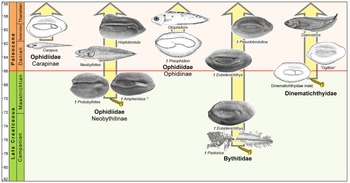The authors would like to correct an error in figure 5. The correct figure is available below.
The authors apologise for the error.

Figure 5. Stratigraphical ranges of ophidiiform lineages across the Late Cretaceous and Paleocene. Skeletal reconstruction is Carnevale & Johnson (2015); drawings of extant fishes are from Markle & Olney (1990), Nielsen (1995), Böhlke & Robins (1959) and Schwarzhans et al. (2005); otoliths are from Schwarzhans (2003) and Schwarzhans & Stringer (2020) and ongoing research.



